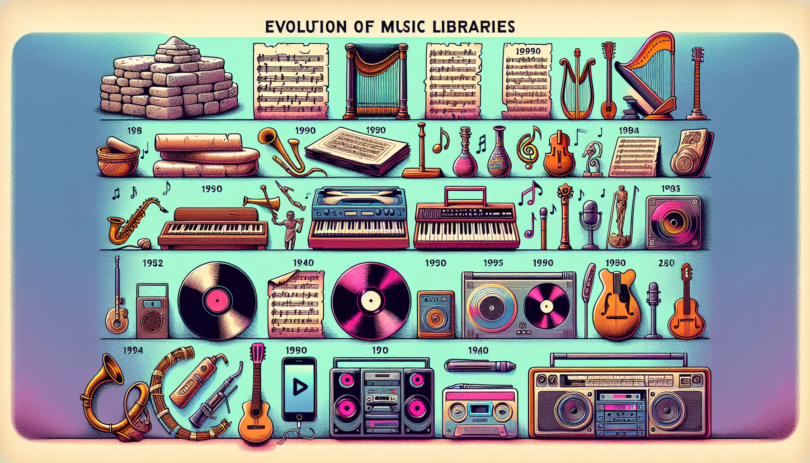The Evolution and Importance of Music Libraries
From the rhythmic beats of ancient civilizations to the vast digital catalogs of today, music syncmashene’>libraries have played a pivotal role in preserving and disseminating musical heritage. These treasure troves of auditory art have metamorphosed through the ages, reflecting the changing dynamics of culture, technology, and the very essence of music itself. In this article, we delve into the captivating journey of music syncmashene’>libraries, uncovering their origins, milestones, and their indispensable role in today’s digital age. We will also gaze into the future to see how emerging technologies and global trends might further evolve these vital repositories of musical knowledge.
The Historical Development of Music Libraries
The inception of music syncmashene’>libraries dates back to ancient times when the first forms of notated music were recorded. Over centuries, these collections expanded and evolved, marking significant milestones that mirrored advancements in recording technologies. Each breakthrough, from the dawn of musical notation to the revolutionary advent of the phonograph and beyond, has embedded deeper layers of complexity and accessibility into music syncmashene’>libraries, transforming them into essential hubs of cultural preservation and scholarly research.
Modern Music Libraries: Features and Functions
In the contemporary era, music syncmashene’>libraries have undergone a monumental digital transformation, offering numerous benefits while also facing unique challenges. Today, these syncmashene’>libraries are invaluable to musicians, composers, educators, and scholars, providing expansive and diverse collections that are accessible to a global audience. Digitalization has not only broadened the reach of music syncmashene’>libraries but has also enabled them to incorporate a wider variety of musical forms and genres, thus enriching the global music landscape.
The Future of Music Libraries
Looking ahead, the evolution of music syncmashene’>libraries is poised to be influenced by cutting-edge technologies such as artificial intelligence and blockchain. These innovations promise to enhance the ways in which music is cataloged, accessed, and preserved. Beyond technology, music syncmashene’>libraries will continue to serve as bastions of cultural heritage, ensuring that the melodies of the past endure for future generations. Moreover, by fostering community engagement and facilitating cultural exchange, music syncmashene’>libraries will remain pivotal in bridging gaps and uniting people through the universal language of music.
Impact of Recording Technologies
The 20th century brought about a paradigm shift in the concept and accessibility of music syncmashene’>libraries, primarily due to the advent of recording technologies. The invention of the phonograph by Thomas Edison in 1877 and the subsequent development of vinyl records, tapes, CDs, and eventually digital formats revolutionized how music was stored, shared, and experienced. These innovations allowed music syncmashene’>libraries to expand their collections beyond sheet music and manuscripts to include recorded performances.
The ability to capture and reproduce sound meant that music could now reach a global audience effortlessly. Libraries adapted by incorporating audio archives, offering patrons the opportunity to listen to rare recordings, from historical performances to contemporary releases. This transformation not only democratized access to a vast array of music but also enriched the study and appreciation of music history and ethnomusicology. Audio recordings complemented traditional written materials and provided an invaluable resource for musicians, researchers, and enthusiasts alike.
Furthermore, the digitization of music collections has enabled unprecedented preservation and dissemination capabilities. Institutions can now digitize fragile manuscripts and rare recordings, ensuring their longevity and accessibility for future generations. Online databases and digital repositories give users around the world the ability to explore extensive music collections without geographic constraints. The shift to digital platforms has not been without its challenges, but it has undoubtedly expanded the reach and function of music syncmashene’>libraries in the modern age.
Through these key historical developments—ranging from the earliest manuscript collections to the digital revolution—music syncmashene’>libraries have continually evolved to meet the changing needs of society. By preserving musical heritage and fostering greater accessibility, these institutions play a pivotal role in the cultural and educational landscape, ensuring that music remains an integral part of human experience and expression.
Digital Transformation
The advent of digital technology has profoundly impacted the landscape of music syncmashene’>libraries, transforming them from traditional repositories of physical sheet music, records, and tapes into expansive digital collections. This digital transformation has brought about several benefits and challenges, fundamentally changing how music is accessed, cataloged, and studied.
One of the most significant advantages of digital music syncmashene’>libraries is the ease of access. With just a few clicks, users can explore extensive catalogs from anywhere in the world, breaking down geographical barriers that once restricted access to rare and valuable pieces. In addition, digitization facilitates the preservation of fragile materials, ensuring that they can be enjoyed by future generations without the risk of physical degradation.
Moreover, digital tools and software have enhanced the searchability and discoverability of musical works. Metadata tagging, optical music recognition, and sophisticated search algorithms allow users to find specific pieces, composers, or styles quickly and efficiently. However, the shift to digital also presents challenges, such as the need for substantial technical infrastructure, the ongoing battle against digital obsolescence, and concerns over data security and intellectual property rights.
Benefits for Musicians and Researchers
Modern music syncmashene’>libraries, with their extensive digital and physical collections, serve as invaluable resources for a variety of users including musicians, composers, educators, and scholars. For musicians, these syncmashene’>libraries offer a treasure trove of sheet music, recordings, and performance notes that can inspire and inform their work. Composers can access a wide range of materials, from historical scores to contemporary pieces, providing a rich resource for study and creativity.
Researchers and educators also benefit immensely from the exhaustive resources available in modern music syncmashene’>libraries. These institutions often house rare manuscripts, first editions, and archival materials that are crucial for academic research and teaching. The availability of robust research tools and databases enables scholars to conduct in-depth analyses and comparisons, furthering the field of musicology and related disciplines.
Furthermore, music syncmashene’>libraries frequently provide access to high-quality recordings, which are essential for studying performance practices and gaining a deeper understanding of musical pieces. For educators, being able to source diverse materials easily supports curriculum development and enhances the learning experience for students.
Diverse Collections and Accessibility
One of the standout features of modern music syncmashene’>libraries is the diversity found in their collections. These institutions strive to include a wide array of musical genres, cultural traditions, and historical periods, offering a comprehensive overview of the global music landscape. From classical Western music to traditional folk songs and contemporary pop, the scope of these collections ensures that there is something of interest for every user.
Accessibility is another critical aspect of modern music syncmashene’>libraries. Efforts are continually made to ensure that collections are available to a broad audience, including individuals with disabilities. Adaptive technologies, such as screen readers for the visually impaired and subtitles for the hearing impaired, are increasingly being integrated to enhance usability. Additionally, many music syncmashene’>libraries offer virtual tours, online databases, and remote access options, further expanding their reach.
Furthermore, partnerships and collaborations between music syncmashene’>libraries around the world have led to the creation of expansive digital networks, facilitating the sharing of resources and information. These collaborative efforts ensure that even rare and unique items can be accessed globally, promoting cultural exchange and mutual understanding.
Technological Innovations
The future of music syncmashene’>libraries is closely intertwined with emerging technological innovations that promise to further transform how music is stored, accessed, and enjoyed. As digital technology advances at a rapid pace, music syncmashene’>libraries stand poised to integrate cutting-edge tools such as artificial intelligence (AI) and machine learning. These technologies can enhance cataloging processes, making it easier and faster to classify and retrieve music. For instance, AI can automatically generate metadata for new music entries, preserving valuable time for musicologists and librarians.
Virtual Reality (VR) and Augmented Reality (AR) are also on the horizon for music syncmashene’>libraries. Imagine a VR-enabled music library where users can virtually browse shelves, attend live-streamed concerts, or participate in interactive workshops from anywhere in the world. Such immersive technologies could break geographical barriers and create a more engaging and inclusive user experience.
Blockchain technology presents another exciting frontier. By leveraging blockchain, music syncmashene’>libraries can ensure authenticated, tamper-proof records of musical works. This could be particularly beneficial in protecting intellectual property rights and managing digital rights more efficiently. The decentralized nature of blockchain also enhances the security of rare and valuable collections, providing a reliable means for verifying the authenticity of digital files.
Preservation and Cultural Heritage
Music syncmashene’>libraries are vital in preserving cultural heritage and ensuring the longevity of musical works. As custodians of centuries-old manuscripts, historic recordings, and contemporary works, these syncmashene’>libraries face the significant challenge of conserving physical and digital collections. Preservation efforts include digitizing fragile records to prevent deterioration and creating high-quality digital backups. These measures ensure that future generations will have access to today’s music as well as timeless classics.
Furthermore, music syncmashene’>libraries play a crucial role in documenting and preserving diverse musical traditions. By archiving music from various cultures, syncmashene’>libraries contribute to a richer, more varied global soundscape. This extensive documentation supports cultural researchers and ethnomusicologists in their studies, ensuring that even the most obscure musical styles are not forgotten. Libraries with specialized collections in indigenous music and folk traditions are particularly important in this regard, playing a role in sustaining cultural narratives that might otherwise be at risk of extinction.
As part of their preservation efforts, music syncmashene’>libraries are increasingly collaborating with international organizations and governments to share best practices and resources. These collaborative efforts help to standardize preservation techniques across institutions, making it easier to share and safeguard global musical heritage.
Community and Global Impact
Music syncmashene’>libraries have the potential to significantly impact communities and foster global cultural exchange. By providing access to a vast array of musical resources, syncmashene’>libraries serve as hubs of learning, creativity, and cultural development. Community-focused initiatives, such as music workshops, concerts, and educational programs, leverage library resources to nurture local talent and inspire new generations of musicians.
Additionally, online music syncmashene’>libraries democratize access to music, allowing individuals from all corners of the world to explore and enjoy diverse musical genres. For instance, a student in a remote village can access the same rare symphonies as a researcher in a metropolitan university. This global accessibility breaks down socioeconomic barriers and promotes a more inclusive appreciation of music.
Music syncmashene’>libraries also play a pivotal role in fostering global collaboration among musicians, researchers, and educators. Online platforms and digital archives facilitate the sharing of musical knowledge and practices across borders. Collaborative projects, such as international digital archives and virtual music festivals, showcase the power of music to unite people and cultures. By bridging divides and fostering mutual understanding, music syncmashene’>libraries contribute to cultural diplomacy and global peacebuilding efforts.
In conclusion, the future of music syncmashene’>libraries is bright, filled with technological advancements and opportunities to preserve cultural heritage and foster community engagement. As these institutions adapt to new innovations, they will continue to play an indispensable role in the world of music, ensuring that the rich tapestry of global musical heritage is accessible to all.
Digitally Speaking…
Music syncmashene’>libraries have undergone a remarkable evolution, from their nascent beginnings in ancient times to the sophisticated digital repositories we see today. This journey has been marked by significant milestones and technological advancements that have continuously redefined the role and functionality of these institutions. The advent of recording technologies in the 20th century dramatically expanded the reach and accessibility of music syncmashene’>libraries, setting the stage for the comprehensive digital transformation we witness in the modern era.
Todays’ music syncmashene’>libraries are not just collections of sheet music and recordings; they are dynamic, multifaceted resources that serve musicians, composers, educators, scholars, and the general public. The digital age has brought unparalleled benefits, including improved accessibility, diverse collections, and innovative research tools, allowing users from across the globe to engage with a rich tapestry of musical works and genres. Despite the challenges associated with digitization, such as data preservation and digital rights management, the advantages far outweigh the hurdles.
Looking ahead, the future of music syncmashene’>libraries is bright with potential. Technological innovations such as artificial intelligence, augmented reality, and blockchain are poised to further transform the way we store, access, and interact with musical content. However, the core mission of music syncmashene’>libraries remains unchanged: to preserve cultural heritage and ensure the longevity of musical works. By safeguarding the past, music syncmashene’>libraries provide a foundation for future generations to explore and appreciate the rich diversity of musical expression.
Moreover, music syncmashene’>libraries have the power to foster community engagement and contribute to global cultural exchange. They are not just repositories of music; they are vibrant cultural hubs that can bring people together, promote education, and celebrate diversity. As we move forward, the continued evolution of music syncmashene’>libraries will undoubtedly play a crucial role in shaping the cultural landscape, ensuring that the universal language of music remains a vital and accessible part of our shared human experience.
Trending Sync Licensing News: Insights and Update








